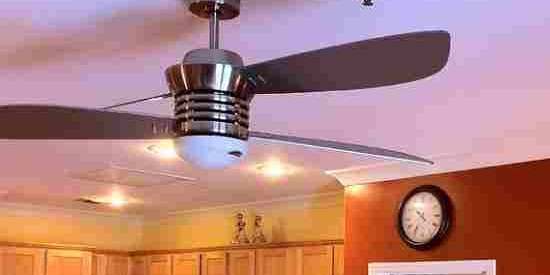How to Clean Your Ceiling Fan
2016-4-9 11:22:07

Since the layer of dust is on the top of a ceiling fan and seldom seen by anyone, you probably put cleaning it low on your list of house cleaning priorities. OK, now is the time to get up there and take a peek, see how bad it looks and see how much yucky build-up is actually up there.
Dust, dirty and grime can build up on the fan blades and housing quickly, even if you keep the fan running constantly. Over time, dirt, dust, smoke and grease from cooking can accumulate and actually damage the finish, especially in the case of wood.
So the truth is that dirty ceiling fans are not just annoying but procrastination could prove costly.
Not to worry though, with some easy cleaning and maintenance tips, you can keep your fan running smoothly and keep dust and dirt from being recirculated in your home.
Things to Consider When Cleaning a Ceiling Fan:
If your ceilings are high, it will limit the tools you can use. Here are some things to consider before cleaning:
. A step stool comes in handy for cleaning most fans, but you have to be careful not to climb too high. NEVER use the top step! It’s easy to get dizzy when you are on a ladder or high step stool. When your eyes are looking straight up at the ceiling, it's easy to lose your balance.
.Protecting your vision is always a smart thing to do. If your step stool doesn’t allow you enough height to look down as you clean the fan, you should use protective eye wear. You may think this is a little bit overboard, but it will stop dust particles and cleaning solution from getting into your eyes..
. If you plan on using a vacuum attachment while standing on a ladder or step stool, be sure your vacuum hose is long enough to keep the vacuum on the floor without having to pull it along as you climb. Hose extensions are available for most for most vacuum cleaners. Use it if you need it.
. Do not try to carry an upright vacuum on a step stool as you clean the fan blades. For the majority of people with high ceilings you should use a telescopic duster (or a homemade version with duct tape and broom handles). Afterward, you can vacuum up any dust that falls. It might seem like a hassle, but your safety is first!
There are several efficient ways to clean your fan. The most important part is the result at the end of your cleaning. The method you chose depends upon the height of your ceiling, the amount of dirt and grime on your fan, the tools you have available, and whether or not you have allergy sufferers and dust must be kept at a minimum in your home.
Choosing Your Cleaning Tools:
I prefer cleaning a ceiling fan by hand because I'm the "get 'er done" type of person. I've learned over time that specialty tools are often a waste of time because they don't do a good job to start with, and end up cluttering your home and collecting dust themselves. An expensive lesson!
Pledge or Swiffer Dust Wipes and Microfiber Cloths:
These are all designed to attract the dust and not scatter it back into the air. Paper towels do a good job too, just spray it first with an all purpose or wood furniture cleaner before attempting to dust or clean.
Feather Dusters:
Feather dusters are very popular and people like to use them because they are quick and easy. I recommend them only for touch ups AND if you are dusting weekly. They are not for heavier dusting because they scatter dust everywhere- into cracks and crevices and they just don't do a complete job at cleaning.
Tools Designed Specifically to Clean Ceiling Fans:
There are fan blade cleaners specifically meant to clean and dust them off. Some are like a sleeve but with only one opening. This is designed to slip on over the blade. You close the opening with your hands and slip it off the fan blade. The dust accumulates in the bag and not all over you or the floor.
Another one is a double prong head duster, you use water to clean. This might be a good option for weekly cleaning.
Vacuum Cleaner Attachments:
I have found the brush tool on a canister vacuum useful to remove loose dust and dirt or cobwebs.
There are a couple problems with using attachments. The most common is that most vacuum cleaner hoses are not long enough to clean the ceiling fan blades, especially with upright vacuums.
It might be useful for you personally, but before purchasing a specialty cleaning tool, ask yourself how easy and effective it will really be.
Dusting the Ceiling Fan:
The easiest way to keep dust at bay is to add this task to your regular weekly (or bi-weekly) cleaning. This is when a feather duster, static duster or one of those specially designed ceiling fan dusters come in handy. Just a light "once over" each blade and you are done.
You can also use a special vacuum attachment. This is handy if your weekly chore list includes vacuuming. Just remember to vacuum the ceiling fan first and then vacuum the floor after.
Regular Cleaning:
Performing a regular cleaning is more efficient than dusting and will dispose of dust instead of redistributing it around the room. A regular cleaning is recommended once a month but it depends on how much dust is flying around your home and how often you use your fan.
1. Step stool or ladder: Get out your step stool and make sure you can get eye level with the fan.
2. Cleaning tools: Use a damp cloth and/or a duster like Pledge, Swiffer, or some other dust-collecting cloth.
3. Wipe down the blades: Use the damp cloth to clean off the blades.
4. Don't let the dust-bunnies fall: Use the dust cloth to catch as many particles (or clumps, if it’s been a while!) as possible when you reach the end of the blade.
5. Go back over the blades if needed: If you have not kept up on dusting and cleaning, you will most likely need to go over the blades a second time with another damp cloth to get any additional dust.
6. Wipe down the housing and mount: Use a clean damp cloth to wipe down the housing and support pole or ceiling mount.
7. Buff it to remove streaks: You may want to buff it after with a clean, dry cloth to restore the shine.
Once you get on a schedule dusting and regular cleaning will not only save time and energy, but also cut down on the dust circulating in your home. It will also make an easier task of your bi-yearly heavy duty cleaning.
Cleaning Tip: If you, or anyone else in your house suffers from dust allergies, the "regular cleaning" vs the dusting method is the most allergy friendly way to keep dust to a minimum.
Heavy Duty Cleaning:
It is recommended that twice a year you should perform a thorough cleaning of your ceiling fans. It is easiest to incorporate them in your spring cleaning and winter cleaning. This especially applies if you forget to do your "regular cleaning" and are only dry dusting them weekly.
1. Preparation: Make sure your ceiling fan and light are turned off, and you might even put a piece of masking tape on the light switch to prevent accidentally turning them on before you are through.
2. Step stool or ladder: It is best to be above eye level with the fan if possible. Make sure you can do this safely.
3. Clean the motor compartment: Most ceiling fans have a compartment surrounding the motor that you can slip down toward you. Open the compartment and use your vacuum hose or canned air to get the dust and dirt near the motor. Close the compartment.
4. Dust ceiling area: and get any cobwebs and dust around the fan with a feather duster or vacuum. Remember the number rule in dusting: start at the top and work your way down!
5. Clean the housing fixture: Be sure to dust the total fixture and, if possible, vacuum any tiny crevices. Use a clean damp cloth and wipe down the support pole or ceiling mount and then the housing. Buff it after with a clean, dry cloth if it has a shiny finish.
6. Remove the globe(s): Put them in a plastic pan or in your sink with soapy, warm water to soak.
7. Wipe down the light bulbs: By now, the light bulbs should be cool enough to touch. Just use a clean cloth and remove any dust. This is a great time to replace any burned out bulbs.
8. Clean and replace globe(s): Wipe out the light globes and rinse them. Dry thoroughly and replace
9. Use a damp cloth AND a treated cloth such as a Pledge, Swiffer, or other dust-collecting cloth. Use the damp cloth to wipe and clean the fan blades while using the dust cloth to catch dust clumps as you reach the end of the blade. You may need to repeat this process if you have neglected regular cleaning!
10. Remove built up dirt and grime: For build up dirt, grime or grease on your fan blades, you may have to use an all purpose cleaner. Use a cloth that is damp or lightly sprayed with all-purpose cleaner. Never spray cleaner near the ceiling fan motor.
Your next weekly cleaning will be much easier, the light in the room will be brighter, and your fan should run quietly!
Keeping Your Ceiling Fan Clean:
Now that your fan is clean and dust free, follow these tips to limit build up and dust from collecting:
. Run the fan often. It is better for the air in your home to circulate and it will keep dust from building up on the blades.
.Use a dryer sheet. Wipe down the blades and the fan housing and all exterior parts with a clean dryer sheet. This will control static cling and repel dust, lint and pet hair that can accumulate. Do this especially if you do not use your fan daily.
With these tips and getting on a schedule (as much as possible) you can make a dreaded task much easier and less stressful. No longer will you have to sit and look at dust hanging down from your ceiling fan or be afraid to turn it on to see a dust storm.



